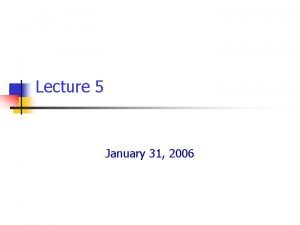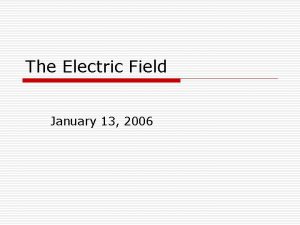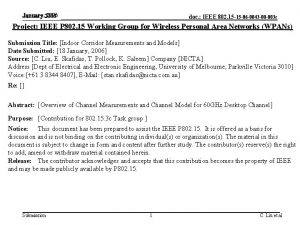January 2006 doc IEEE 802 11 060013 r





- Slides: 5

January 2006 doc. : IEEE 802. 11 -06/0013 r 0 What is 802. 11 u? Date: 2006 -01 -06 Authors: Notice: This document has been prepared to assist IEEE 802. 11. It is offered as a basis for discussion and is not binding on the contributing individual(s) or organization(s). The material in this document is subject to change in form and content after further study. The contributor(s) reserve(s) the right to add, amend or withdraw material contained herein. Release: The contributor grants a free, irrevocable license to the IEEE to incorporate material contained in this contribution, and any modifications thereof, in the creation of an IEEE Standards publication; to copyright in the IEEE’s name any IEEE Standards publication even though it may include portions of this contribution; and at the IEEE’s sole discretion to permit others to reproduce in whole or in part the resulting IEEE Standards publication. The contributor also acknowledges and accepts that this contribution may be made public by IEEE 802. 11. Patent Policy and Procedures: The contributor is familiar with the IEEE 802 Patent Policy and Procedures <http: // ieee 802. org/guides/bylaws/sb-bylaws. pdf>, including the statement "IEEE standards may include the known use of patent(s), including patent applications, provided the IEEE receives assurance from the patent holder or applicant with respect to patents essential for compliance with both mandatory and optional portions of the standard. " Early disclosure to the Working Group of patent information that might be relevant to the standard is essential to reduce the possibility for delays in the development process and increase the likelihood that the draft publication will be approved for publication. Please notify the Chair <stuart. kerry@philips. com> as early as possible, in written or electronic form, if patented technology (or technology under patent application) might be incorporated into a draft standard being developed within the IEEE 802. 11 Working Group. If you have questions, contact the IEEE Patent Committee Administrator at <patcom@ieee. org>. Submission 1 Mike Moreton, STMicroelectronics

January 2006 doc. : IEEE 802. 11 -06/0013 r 0 Abstract This document gives a brief personal overview of the aims of 802. 11 u. As we’re still at the call for proposals stage, at this point we can’t be explicit about how these aims will be achieved. Submission 2 Mike Moreton, STMicroelectronics

January 2006 doc. : IEEE 802. 11 -06/0013 r 0 802. 11 u in a Nutshell • IEEE 802. 11 currently assumes that you are preauthorised to use the IEEE 802. 11 network – When you come to connect, you already have all the security credentials you need (if any) • IEEE 802. 11 u considers the case when you don’t – You could enrol with the network (e. g. Wi-Fi’s UAM) – You could use the network to get access to one that you do have credentials for • Hot spot roaming • Enterprise Virtual Networks – You could find a network that is advertising it will give you the service you need without credentials • “Free” services • Emergency call (E 911) support • Local information services that don’t provide general Internet access Submission 3 Mike Moreton, STMicroelectronics

January 2006 doc. : IEEE 802. 11 -06/0013 r 0 A User Perspective • You turn on your laptop in your hotel room, and it detects 15 different SSIDs that you’ve never heard of: – tsunami, Loadsadrone, linksys, Oh. No, Coffee. To. Go, Southern. Knocker, Uneec, Eighty 4 Tea, High. Rate. Hotels , Almost. Groped 2, Real. Almost. Groped, Genuine. Almost. Groped. Dont. Trust. The. Others. Because. Theyre. Hackers • What do you do? • With 802. 11 u you’ll know – – Submission which networks provide free service, which networks you can use based on your home subscriptions which networks you could enrol with which networks don’t provide any public service (so you can’t use them) 4 Mike Moreton, STMicroelectronics

January 2006 doc. : IEEE 802. 11 -06/0013 r 0 IEEE 802. 11 u – Why Bother? • Question: Hotspots exist, roaming agreements exist, so why do we need TGu? – Some existing solutions assume no MAC layer changes • But can be klunky, inefficient and unscalable as a result – Some existing solutions assume proprietary MAC extensions • E. g. multiple SSIDs in a Beacon or Probe Response • But these are non-standard, and hence risky and often will not scale to larger networks. – Some existing solutions use layer 3 and above (i. e. IP family) techniques to overcome problems • Assume trusted relationship between AP and network • Problems with scalability and inefficiency • No layer 2 fast roaming (TGr) • TGu exists to “do it right” – Stop hacking, and fix the problems properly – Do the bits that have to be done at L 2, and leave the rest to others Submission 5 Mike Moreton, STMicroelectronics









